NVIDIA's GeForce GTX 560 Ti w/448 Cores: GTX 570 On A Budget
by Ryan Smith on November 29, 2011 9:00 AM ESTPower, Temperature, & Noise
Last but certainly not least is our look at power, temperature, and noise. If we’ve clearly established that the GTX 560-448 has more in common with the GTX 570 than the GTX 560 Ti in gaming performance, then let’s see if the operational attributes are equally close.
| GeForce GTX 500 Series Voltages | ||||
| Ref 580 Load | Ref 570 Load | Zotac 560-448 Load | ||
| 1.037v | 1.025v | 1.000v | ||
Looking quickly at voltage, our Zotac card is set to 1.0v. This is actually 0.025v less than our reference GTX 570 and GTX 580 cards, though it’s important to note that all of these cards have a wide VID range. Realistically speaking we expect that the GTX 560-448 would have a similar to greater VID range than the GTX 570.
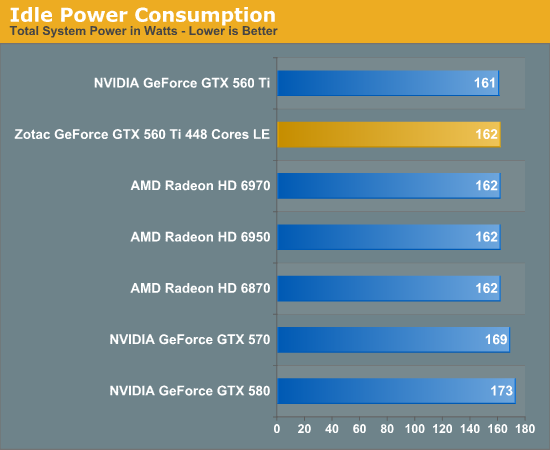
It’s quite interesting to find that idle system power consumption is several watts lower than it is with the GTX 570. Truth be told we don’t have a great explanation for this; there’s the obvious difference in coolers, but it’s rare to see a single fan have this kind of an impact.
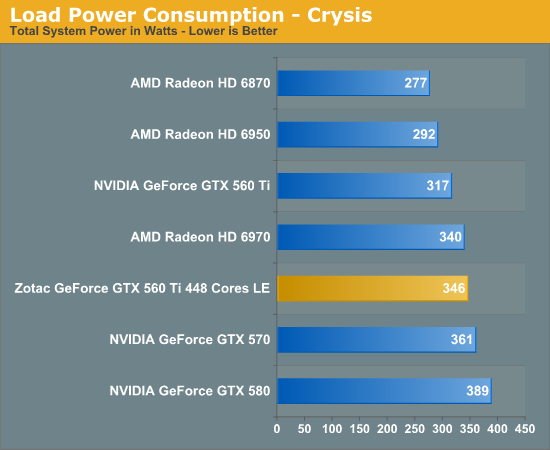
Power consumption under load shows a similar benefit. With the Zotac GTX 560-448 we’re drawing 15W less than with the reference GTX 570. Given that the performance of the Zotac GTX 560-448 is so close to the GTX 570, and this actually starts looking like a cheaper GTX 570 with lower power consumption, which is not something we would have expected to find. But at the same time this means load power consumption is still nearly 30W greater than the GTX 560 Ti, is a very distinct difference for two products sharing the same name.
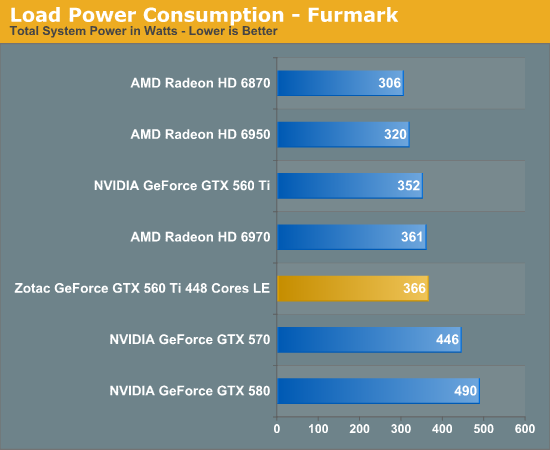
FurMark is thrown in for consistency, but at this point NVIDIA’s driver throttling is so extreme that FurMark is instantly beaten back when started.
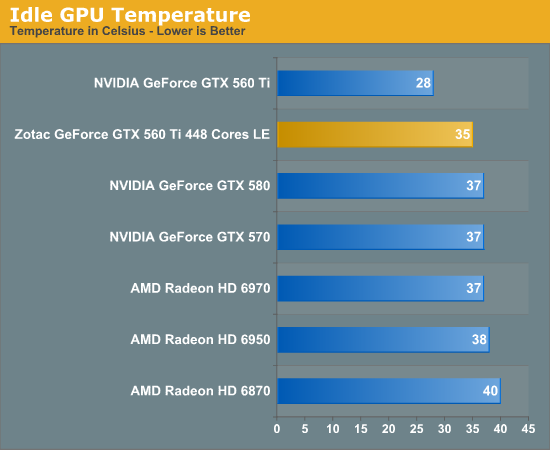
When it comes to GPU temperatures, idle temperatures straddle the difference between the GTX 560 Ti and the GTX 570. The open-air cooler is usually better for lower temperatures, but at the same time GF110’s higher idle power consumption negates some of this benefit. In any case it’s still one of the coolest high-end cards at idle.


Meanwhile GPU load temperatures are at the middle of the pack. Like all GF110 products the Zotac GTX 560-448 starts getting toasty under load (even with the open-air cooler), but it’s still noticeably cooler than the GTX 570 and GTX 580. With that said the open-air cooler means that this is going to be case-dependent, so cases with poor airflow would favor the closed coolers of the GTX 570 and GTX 580.
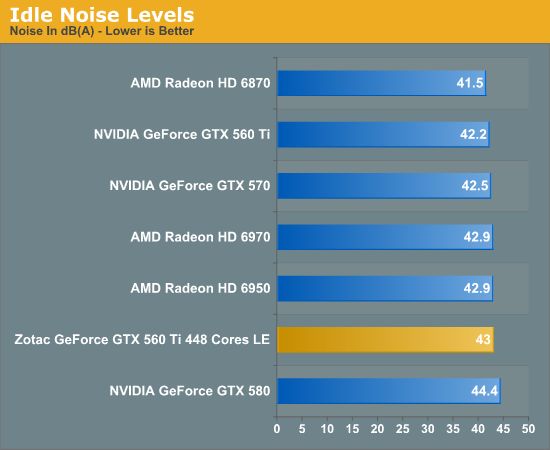

Finally we have our look at noise. The Zotac GTX 560-448 idles just a hair louder than most of our other high-end cards, including the GTX 570. Under load however that open-air cooler really makes its mark among a crowd of closed coolers, leading to noise levels little above the GTX 560 Ti and remarkably quieter than the GTX 570. On a performance/noise spectrum this is fantastic, but the devil is in the details: you need a case with good airflow to make this happen. Otherwise the Zotac GTX 560-448 ramps up significantly once temperatures approach 90C.










80 Comments
View All Comments
Marlin1975 - Tuesday, November 29, 2011 - link
hahahha.... spoken like a true nvidia employee/spokesman/shill.Mathieu Bourgie - Tuesday, November 29, 2011 - link
"Then the issue of microstutter arises which barely affects nVidia hardware, for what can only be presumed to be a ATI driver problem."That's rubbish, Tech Report and Tom's Hardware articles covering micro-stuttering clearly proved that micro-stuttering is an issue on both AMD and Nvidia video cards.
While I'll agree that on average, Nvidia drivers tend to be less problematic, the quality of AMD drivers has improved over the years, aren't as problematic as they used to be and aren't nearly as far behind Nvidia drivers as you paint it.
greylica - Tuesday, November 29, 2011 - link
It's another card based on Ferm(ented) hardware. I will pass by for all of GTX 4XX and 5XX waiting for cards that do respect their own specifications in OpenGL without fails like the well known Nvidia problem about GLReadPixels...Alka - Tuesday, November 29, 2011 - link
Hey, I've seen you're picture before Mathieu. Aren't you the guy who steals the Tom's Hardware best graphics cards for the month format and content? You pass it off as your own on your personal blog, right?Mathieu Bourgie - Tuesday, November 29, 2011 - link
Stealing from their content?If you paid attention to the content of my article and compared it to the content of Tom's Hardware article, you'd notice that my recommendations tend to be quite different from theirs and that they are backed by factual performance numbers coming from various sources, including AnandTech. I also tend to publish my monthly updates before Tom's Hardware do.
Stealing "their" format?
It's like saying that PC makers are copying Apple ideas because "Apple did it first", when Apple didn't do it first. Apple took an existing idea and improved on it and then when some PC makers decided to have their take on the idea, Apple fanboys are crying that PC makers are copying "Apple's idea".
In the past, many other websites, who write about various topics, did "value comparison" articles and did so before Tom's Hardware did theirs. Guess what? Such "value comparison" articles existed before the Internet was mainstream.
The concept that I'm stealing "their" format is as ridiculous as someone saying that website B, who did a review on the latest CPUs, stole website A format because website A were the first to review the latest CPUs.
Alka - Tuesday, November 29, 2011 - link
Dude, you've directly copied and pasted sections of their article without giving credit. That's beyond your own take on a value comparison.Do you really want me to post specific examples of your plagiarism?
Mathieu Bourgie - Tuesday, November 29, 2011 - link
Alka,While I wouldn't be surprised that our articles share some similarities, including similar recommendations, which is to be expected since our articles cover the same products available on the market, accusing me of directly copying and pasting sections of their article without giving credit is taking your comment to a whole other level of disrespect and makes me wonder what's your goal here, if not only trolling...
"Do you really want me to post specific examples of your plagiarism? "
While I'd have no problem listening to you and perhaps making some correction(s) to my article if it possibly looks like someone may think that I could have copied content from Tom's Hardware article, I would rather not do this over this comments section at AnandTech, out of respect for Ryan, Anand and the rest of AnandTech's team, whose articles I truly enjoy and wouldn't want to add a bunch of unrelated comments to their great articles.
I invite you to contact me via:
- The contact form on my website
- Facebook
- Twitter
- Google my name
- Etc.
You have plenty of ways to reach me if you want to further discuss this, without filling this comment section with comments unrelated to this article and without bothering everyone else here.
Thanks,
Mathieu
Alka - Wednesday, November 30, 2011 - link
No point, you've clearly convinced yourself that shameless plagiarism is acceptable without giving proper credit.JonnyDough - Thursday, December 1, 2011 - link
Irregardless of any fanboyism here, or whether or not you steal text,"That's rubbish, Tech Report and Tom's Hardware articles covering micro-stuttering clearly proved that micro-stuttering is an issue on both AMD and Nvidia video cards."
That is truth.
formulav8 - Tuesday, November 29, 2011 - link
One of the most useless and fannish posts on here.